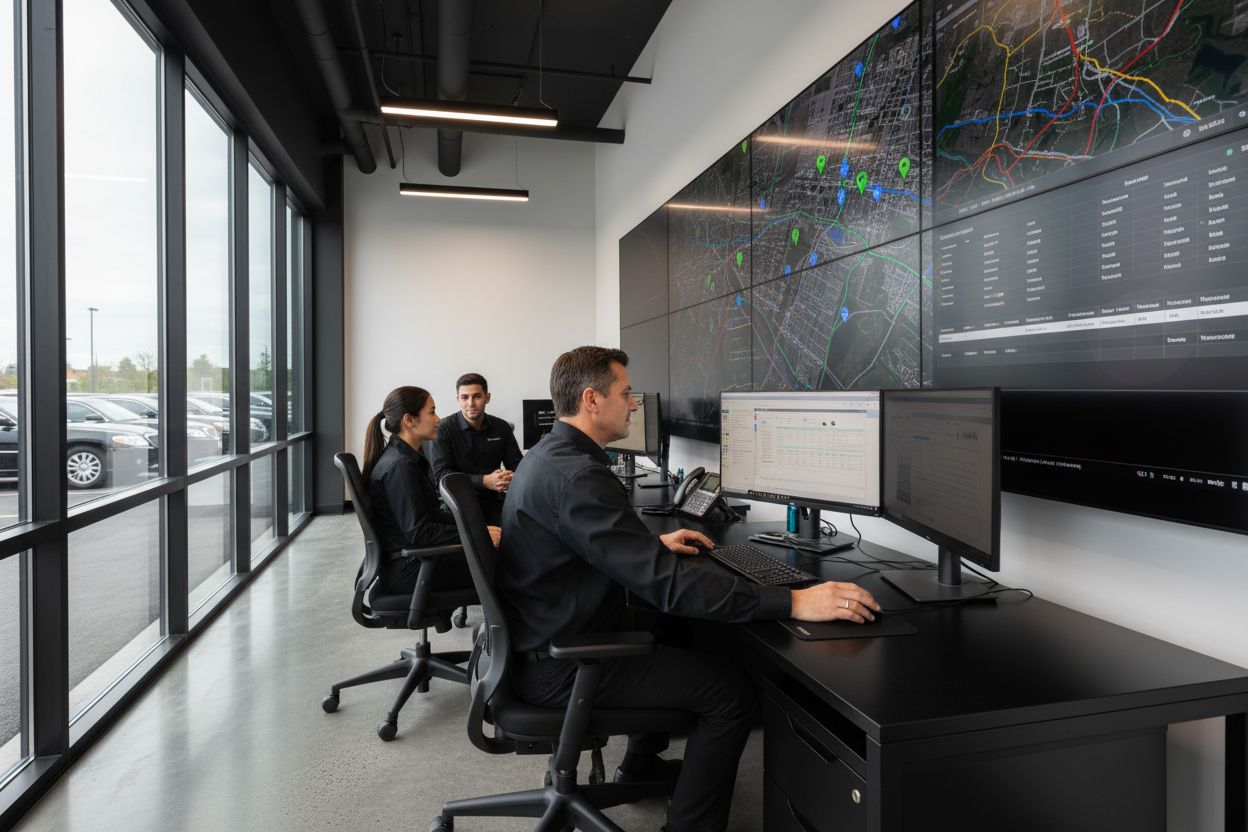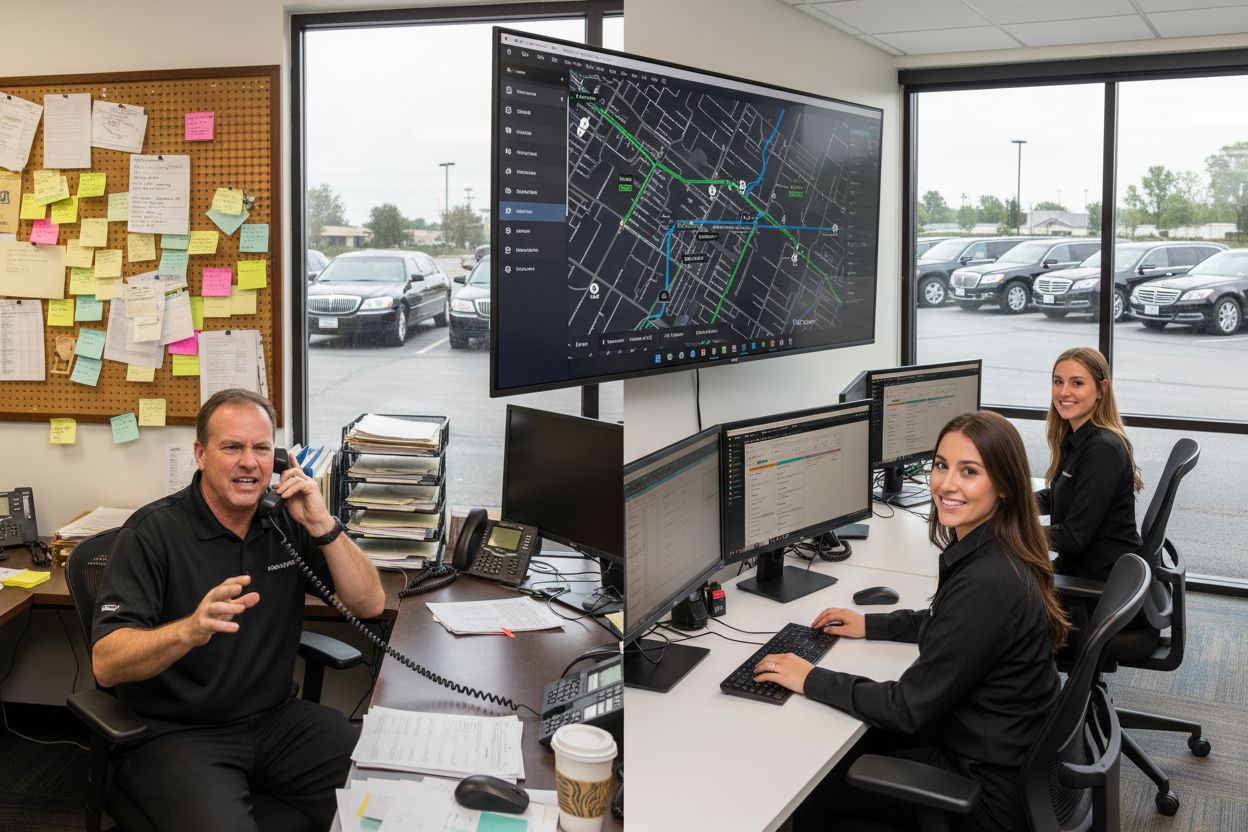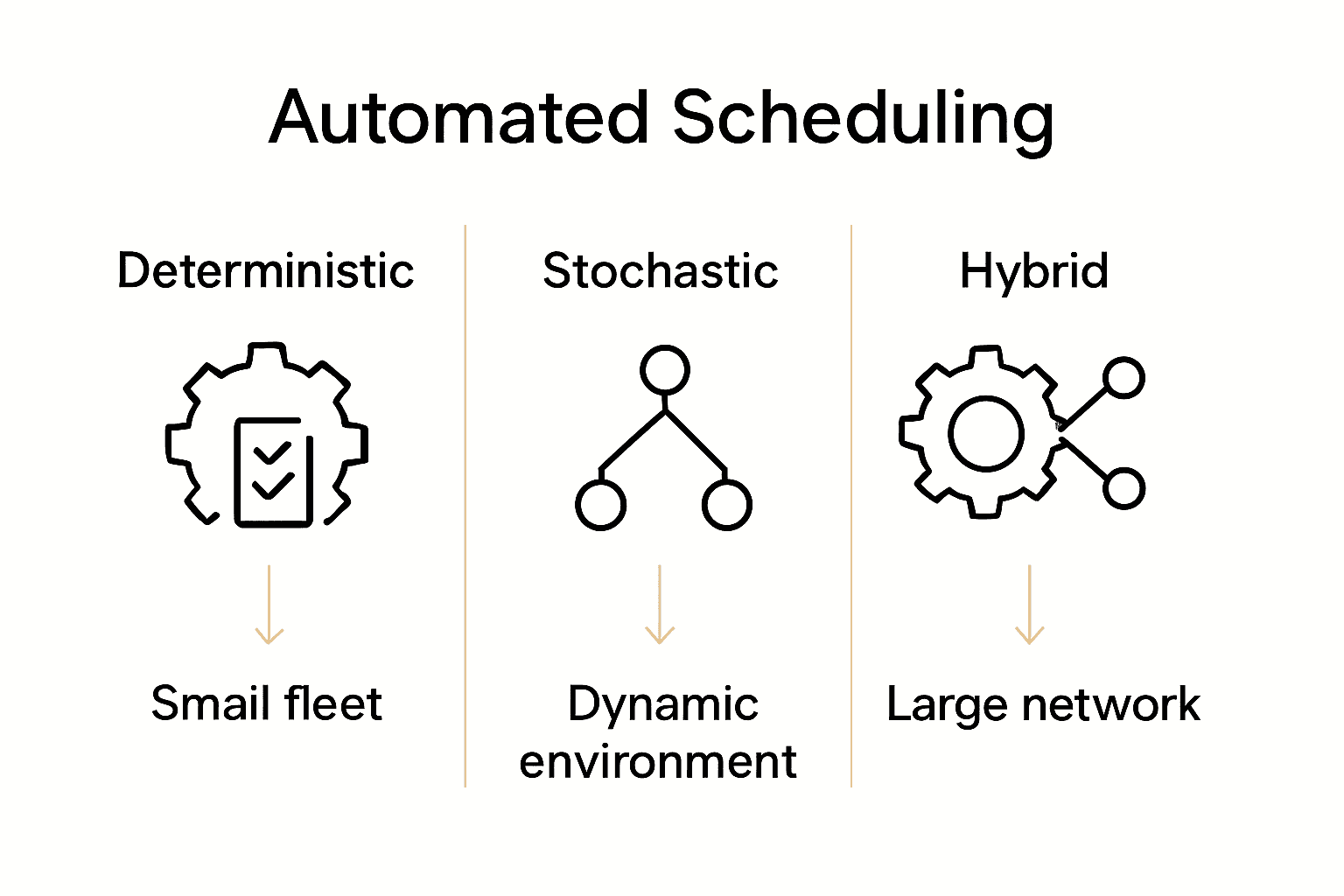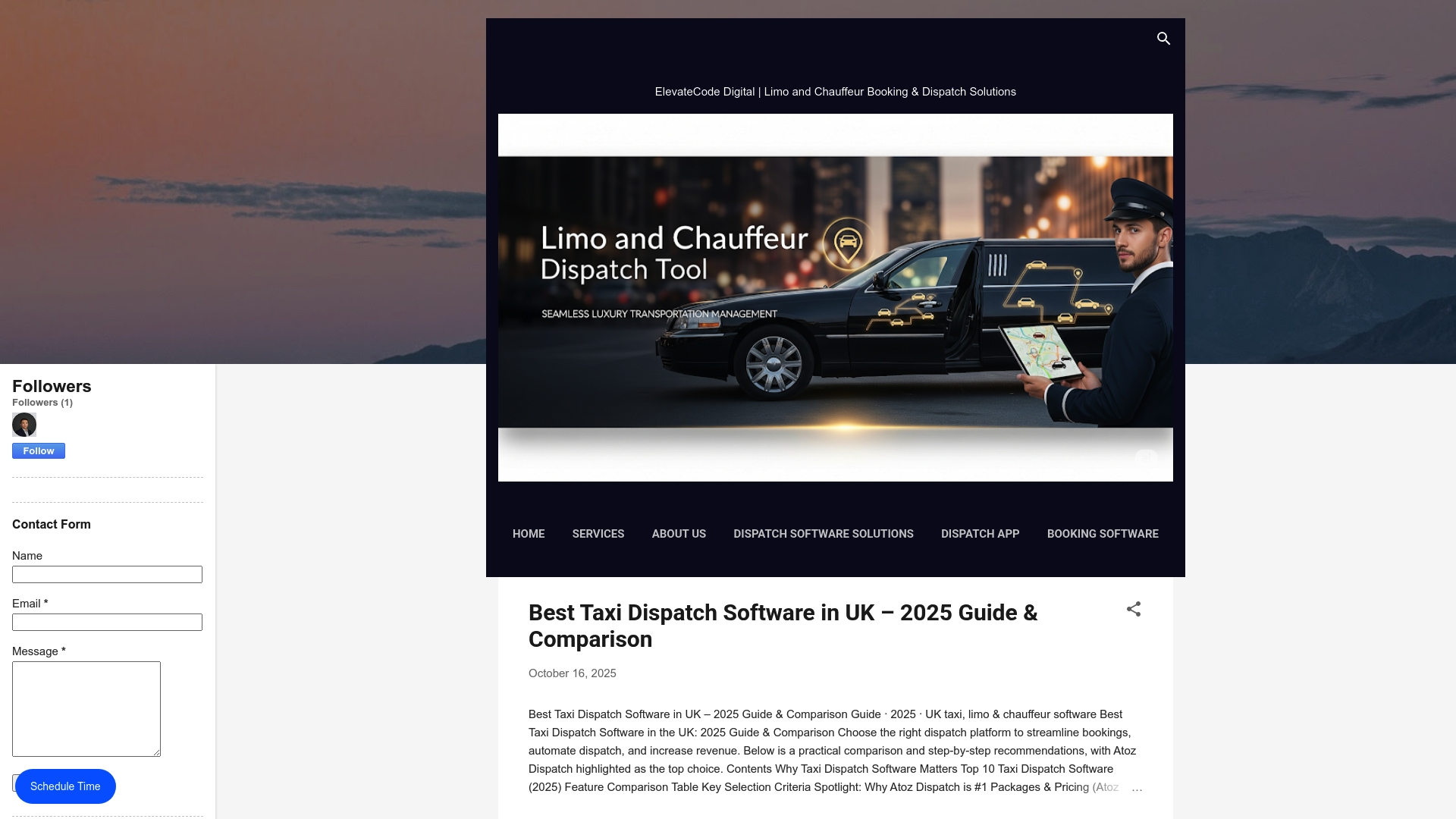Automated Scheduling: Essential Guide for Limo Dispatch
Automated Scheduling: Essential Guide for Limo Dispatch

Imagine slashing your dispatch planning time by up to 75 percent without adding extra staff. As the demand for faster, more accurate transportation services grows, many limo and taxi operators are turning to automated scheduling systems for relief. This shift not only speeds up day-to-day operations but also lets managers oversee more drivers with less effort. By using technology to make smarter decisions and cut routine tasks, transportation providers can maximize efficiency and stay competitive.
Key Takeaways
| Point | Details |
|---|---|
| Automated Scheduling Benefits | Enhances operational efficiency by reducing planning time, optimizing costs, and increasing driver management capacity. |
| Types of Systems | There are three primary scheduling models: deterministic, stochastic, and hybrid, each catering to different operational needs. |
| Data Quality Importance | Success depends on high-quality data inputs, consistent logic, and adaptive algorithms to ensure smooth operations. |
| Human-Tech Integration | Effective automation requires balancing technology’s efficiency with human oversight to manage complex scenarios and maintain customer relations. |
Table of Contents
- What Automated Scheduling Means
- Types Of Automated Scheduling Systems
- How Automated Scheduling Works In Dispatch
- Key Requirements For Automated Scheduling
- Benefits And Operational Impacts
- Risks, Limitations And Alternatives
What Automated Scheduling Means
Automated scheduling represents a technological leap for transportation service providers, transforming how limo and taxi operators manage their fleet operations. Automated dispatch is essentially a smart system that uses technology to streamline vehicle assignment, route planning, and operational management without constant human intervention.
At its core, automated scheduling does three critical things for transportation businesses:
- Reduces manual planning time dramatically (up to 75% faster)
- Minimizes operational costs by optimizing fuel and route efficiency
- Enables managers to handle significantly more drivers with less effort
According to research from Optimal Dynamics, automated systems allow one manager to handle 3–4 times more drivers compared to traditional manual dispatching. This means your team can scale operations without proportionally increasing administrative overhead.
The real magic happens through consistent rule-based decision making. Instead of relying on individual dispatcher judgments, automated scheduling creates standardized protocols that apply the same logic every single time. This approach not only reduces human error but also provides the unique ability to simulate potential policy changes before actual implementation. Your dispatch decisions become more predictable, efficient, and data-driven.

In practical terms? You’re essentially giving your transportation business a digital operations manager that works 24/7, makes instantaneous decisions, and continuously optimizes your fleet’s performance.
Types Of Automated Scheduling Systems
Automated scheduling systems for transportation services are not one-size-fits-all solutions. Scheduling models vary significantly, each designed to address specific operational needs and complexity levels. Understanding these different types helps transportation providers choose the right technological approach for their specific business requirements.
Research indicates three primary frameworks of scheduling systems:
- Deterministic Systems: Operate with precise, predefined rules and fixed parameters
- Stochastic Systems: Incorporate probabilistic elements and can adapt to changing variables
- Hybrid Systems: Combine deterministic and stochastic approaches for maximum flexibility
According to research from MDPI Logistics Research, these scheduling models leverage different algorithmic strategies such as exact, heuristic, and meta-heuristic approaches. This means some systems use rigid mathematical calculations, while others employ more adaptive, intelligent decision-making techniques.
For transportation services like limo and taxi operations, advanced AI-driven dispatch tools represent the cutting edge. These systems go beyond basic scheduling by integrating with broader business management platforms. As highlighted by GoComet Research, modern scheduling systems can now predict potential disruptions, select optimal routing strategies, and make real-time adjustments based on complex data inputs.
The key is selecting a system that matches your operational complexity. Small fleets might need simple deterministic systems, while large transportation networks require sophisticated hybrid approaches that can dynamically optimize resources and anticipate potential challenges.
Here’s a comparison of the main types of automated scheduling systems:

| Scheduling System Type | Key Features | Best For |
|---|---|---|
| Deterministic | Fixed rules Predictable outputs |
Small fleets Simple operations |
| Stochastic | Adapts to variables Uses probabilities |
Dynamic environments Variable demand |
| Hybrid | Combines rule-based & adaptive Highly flexible |
Large networks Complex requirements |
How Automated Scheduling Works In Dispatch
Automated scheduling transforms dispatch operations from manual guesswork into a precision-driven technological process. At its core, these systems function like intelligent digital command centers, continuously processing complex transportation logistics in real-time.
According to Ride Wyze Research, the automated scheduling process involves gathering and analyzing multiple data streams simultaneously:
- Real-time driver location tracking
- Current traffic conditions
- Weather patterns
- Driver availability
- Customer demand signals
The system’s algorithms then instantaneously match these variables, selecting the most optimal driver, route, and scheduling configuration. This means your dispatch isn’t just assigning vehicles—it’s dynamically solving a complex mathematical optimization problem in milliseconds.
As highlighted by Zip24 Logistics Research, dispatch scheduling software uses GPS and centralized data systems to monitor driver locations continuously. The technology can adjust schedules on-the-fly, sending real-time updates to both drivers and customers. This creates a responsive, transparent operational ecosystem where every vehicle movement is tracked, predicted, and optimized.
The magic happens through sophisticated machine learning algorithms that get smarter with each dispatch. The more data the system processes, the more precisely it can predict optimal routing, estimate arrival times, and balance driver workloads. What used to take hours of manual planning now happens instantaneously, with remarkable accuracy.
Key Requirements For Automated Scheduling
Successful automated scheduling isn’t just about purchasing software—it’s about building a robust technological ecosystem that can transform your transportation operations. Think of it like constructing a sophisticated digital nervous system for your business, with multiple critical components working in perfect harmony.
According to research from Trax Technologies, data quality is the foundation of any effective automated system. Poor data can derail your entire operation, with studies showing that 55% of AI project failures stem directly from inadequate or incorrect information inputs.
Key requirements for an effective automated scheduling system include:
- High-Quality Data: Accurate, real-time information from multiple sources
- Consistent Rule Logic: Standardized decision-making protocols
- Adaptive Algorithms: Systems that can adjust to changing market conditions
- Simulation Capabilities: Ability to test policy changes before implementation
- Scalable Infrastructure: Technology that grows with your business needs
Research from Optimal Dynamics emphasizes the importance of adaptability in automated dispatch systems. The most effective platforms aren’t rigid—they’re dynamic environments that can simulate ‘what-if’ scenarios, allowing managers to test potential policy changes without risking actual operational disruption.
Ultimately, successful automated scheduling requires more than just technology. It demands a strategic approach that combines sophisticated software, high-quality data inputs, and a willingness to reimagine traditional dispatch operations. Your system should work like a digital co-pilot, making split-second decisions that optimize efficiency, reduce costs, and enhance overall operational performance.
Benefits And Operational Impacts
Automated scheduling isn’t just a technological upgrade—it’s a comprehensive operational transformation that touches every aspect of transportation service delivery. By leveraging intelligent systems, limo and taxi operators can fundamentally reshape their business performance and competitive positioning.
According to research from Continuous Quest, the quantifiable benefits of automation are remarkable:
- 30% increased vehicle utilization
- 40% reduction in customer service calls
- 20-30% fuel cost savings
- 20-25% overtime reduction
- 25% more on-time deliveries
- 30% improved driver productivity
- 40% higher customer satisfaction
GoComet Research highlights that automated scheduling significantly enhances operational efficiency. The system doesn’t just optimize routes—it creates a holistic improvement ecosystem, reducing operational errors by 45% and providing real-time tracking that transforms customer experience.
Beyond raw numbers, automated scheduling fundamentally changes how transportation businesses operate. It shifts your organization from reactive management to proactive strategic planning. Managers move from constantly putting out operational fires to making data-driven decisions that anticipate and prevent potential challenges. Your dispatch center becomes less about manual coordination and more about strategic optimization, with technology handling complex routing calculations in milliseconds.
The true power of automated scheduling lies in its ability to create a more responsive, efficient, and customer-centric transportation service. What was once considered cutting-edge technology is rapidly becoming the standard for competitive, modern transportation operations.
Risks, Limitations And Alternatives
Automated scheduling represents powerful technology, but it’s not a magic solution that works perfectly in every scenario. Smart transportation operators understand both the incredible potential and the inherent limitations of these intelligent systems.
According to Optimal Dynamics Research, automated systems face several critical challenges:
- Dependency on consistently high-quality data inputs
- Potential inflexibility during unexpected market shifts
- Need for continuous human oversight
- Complex exception management requirements
Tomorrow Desk Research reveals a significant workforce implication: AI systems might potentially displace 60-70% of traditional dispatcher decision-making tasks. This statistic underscores the importance of strategic human-technology integration rather than complete technological replacement.
Alternatives to full automation include hybrid models where technology handles routine tasks while human dispatchers manage complex scenarios, maintain customer relationships, and ensure compliance. These approaches allow businesses to leverage technological efficiency without completely eliminating human judgment and flexibility.
Ultimately, successful implementation requires viewing automated scheduling as a sophisticated tool, not a complete operational replacement. The most effective transportation services will be those that strategically balance technological capabilities with nuanced human expertise, creating a collaborative ecosystem that maximizes efficiency while maintaining the critical human touch that customers value.
Step Into Effortless Limo Dispatch With Powerful Automation
Handling limo dispatch manually drains valuable time and leads to constant stress. If you are struggling with inefficient route planning, rising operational costs, and difficulty scaling your business as described in our guide on automated scheduling, you are not alone. These pain points can make it hard to keep up with customer expectations and ever-changing transportation demands. But now, smarter dispatch is within your reach.

See firsthand how the right technology can transform your limo operations. Discover how Limo Dispatch software automates scheduling and dispatching with real-time data, advanced optimization, and easy-to-use tools. Stop letting manual processes hold you back. Visit https://elevatecodedigital.com today to schedule your demo and make efficient, reliable limo dispatch a reality for your business. The future of limo scheduling is just a click away.
Frequently Asked Questions
What is automated scheduling in limo dispatch?
Automated scheduling refers to a technology-driven approach that optimizes fleet management for transportation services. It streamlines dispatch processes by using smart systems to assign vehicles, plan routes, and manage operations efficiently without constant human oversight.
What are the benefits of using automated scheduling?
Automated scheduling offers several benefits, including increased vehicle utilization by up to 30%, reduced operational costs, enhanced efficiency with a 45% decrease in operational errors, and improved customer satisfaction through on-time deliveries and better service experience.
How does automated scheduling work in dispatch operations?
Automated scheduling systems gather and analyze various data streams in real-time, such as driver locations, traffic conditions, and customer demand. Using advanced algorithms, they dynamically match these factors to select the best driver and routing options, optimizing dispatch operations instantaneously.
What types of automated scheduling systems are available for limo services?
There are three primary types of automated scheduling systems: Deterministic systems, which follow fixed rules; Stochastic systems, which can adapt to changing variables; and Hybrid systems, which combine both approaches for maximum flexibility and efficiency in complex operational environments.

Comments
Post a Comment